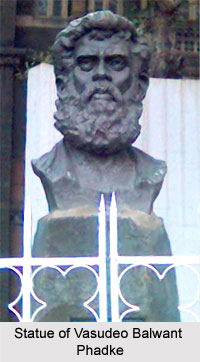 Vasudeo Balwant Phadke was the harbinger of that radical movement which was launched by the youth of India with a passionate urge to exterminate the British rule, after the Revolt of 1857 proved futile.
Vasudeo Balwant Phadke was the harbinger of that radical movement which was launched by the youth of India with a passionate urge to exterminate the British rule, after the Revolt of 1857 proved futile.
Phadke was born on 4th November 1845 in a rich family of Shirdhon. Though he did not complete his school education, yet he had a striking command over English. After serving in the Audit Office of the Great Indian Peninsula Railway for some time, he joined the Military Finance Office at Pune in 1865. He married Sai Bai in 1859 who died in 1873, leaving behind a daughter. Phadke`s second marriage was with Godubai of Padohavli.
In 1870 Phadke applied for leave to go to his village Shirdhon to be by the side of his dying mother. The leave was not approved, but when it was granted after a good deal of imploring, his mother had already passed away. The event altogether altered the course of his life. A rebel was born within him. While on a long leave in 1872 Balwant Phadke started planning against the government at the time when there existed almost a political abatement, though Govind Ranade was circularising swadeshi and Bal Gangadhar Tilak was just to enter dynamic politics in 1880.
He attracted a band of committed workers ready to fight for the freedom of the country. Phadke`s residence became the centre of planning for revolutionary activities. He started training classes to awaken and excite the nascent militants for the cause. The young men, including Phadke`s wife Godubai, attained expertise in handling arms and ammunitions.
However, there was a dearth of funds and weapons could not be acquired. The poor were powerless and the rich were indifferent. In February 1879, Phadke`s comrades including Vishnu Vinayak Gadre, Gopal Moreshwar, Sathe, Ganesh Krishna Deodhar and Gopal Hari Karve violently ransacked the rich of the area and raised the banner of revolt. The news terribly alarmed the authorities.
In May 1879, Phadke strongly reprobated the economic policy of the British. His declaration electrified the masses. The government announced the awards for capturing Vasudeo and his companions. In response, Phadke announced even bigger rewards for capturing the governor and the collector and the sessions judge of Pune, rendering the government much more unsettled. Phadke`s companion Daulat Rai was killed on 17th May 1879. Phadke and Gopal Moreshwar were arrested on 20th July 1879.
He was charged with machinating to wage a war against the king and sedition. The trial started on 3rd November 1879, Phadke was convicted on 7th November 1879 and sentenced to transportation for life to `Kala Pani`. His 14 companions were sentenced to penal deportation for ten to twenty-five years each. Phadke made a heroic appearance, while his countrymen looked at him in consternation.
Phadke was sent to Aden where he reached on 9th January 1880 and his companions were deported to the Andamans. Phadke tolerated all the trials and tribulations of the miserable confinement. He tried to escape from jail once, but was recaptured. Phadke breathed his last in the fort of Aden on 17th February 1883.
Vasudeo Balwant Phadke was the first patriot of modern India who preached the use of arms against the British and his case was the first sedition case to be followed by a number of such cases in the tumultuous period of India`s freedom movement.



















